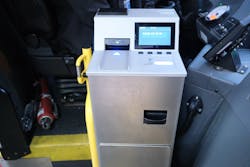CTA testing next generation bus farebox system
The Chicago Transit Authority (CTA) began testing new fareboxes on in-service buses, before gradually rolling them out fleet-wide. The tests are a part of the CTA's continued investments to modernize Chicago’s public transit system.
The current fareboxes, in use for more than 30 years, are being replaced with a more modern, on-board bus operating system that provides riders with an improved user experience, especially those paying with cash and will also facilitate more efficient operations at CTA’s bus garages.
“Updating the farebox systems is greatly needed to modernize the front- and back-ends of our bus operations,” said CTA President Dorval R. Carter, Jr. “We are always striving to provide our customers with a more convenient travel experience, in this case that includes improved fare transactions, as well as well as more reliable equipment.”
The next generation farebox features a new, easier to read customer display screen and audio signals similar to the Ventra card validators on the rail system. The updated system can report ridership data and revenue and identify farebox defects. The new upgrades will improve the efficiency of CTA’s data collection, which in turn provides better insights for improving the everyday customer experience.
The initial roll-out of the program will entail the installation and field testing of 100 updated buses through spring. The equipment will be installed on buses operating out of CTA’s Chicago Avenue Garage on the West Side, which serves some of the agency’s highest ridership routes, including: #12 Roosevelt, #20 Madison, #53 Pulaski, #65 Grand and #66 Chicago.
The CTA has a fleet of more than 1,800 buses, systemwide. Following the successful testing of the first 100 buses, CTA will begin rolling out the equipment to the remaining bus fleet beginning in summer and through the end of year.
The Chicago Transit Board approved the awarding of the roughly $41 million contract to Scheidt & Bachmann during its October 2022 meeting, following a competitive procurement process. The contract value includes costs for the new equipment, software and installation, as well as five years of ongoing support with warranty and the option to extend in the future.






